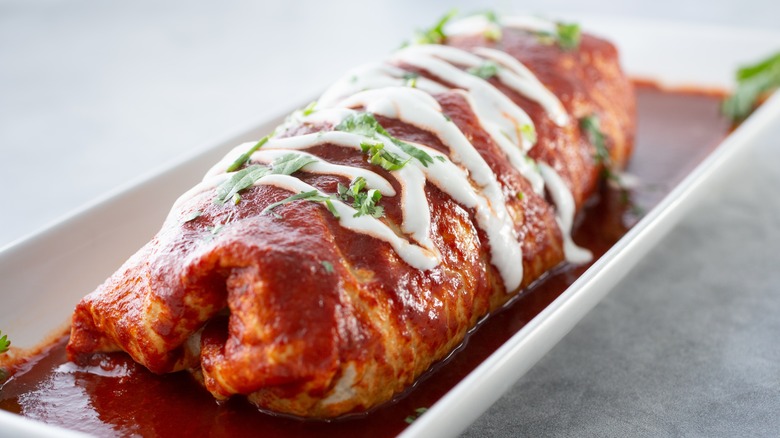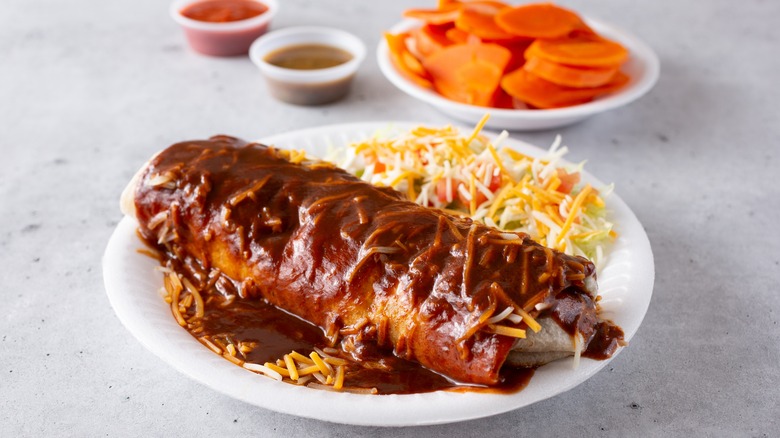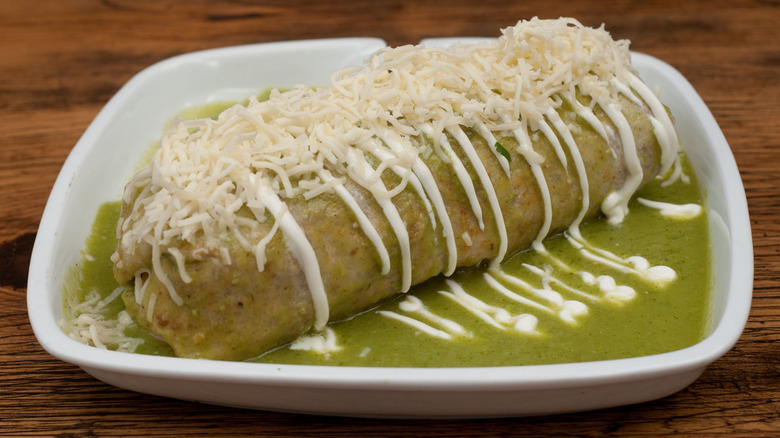What Sets Wet Burritos Apart From Regular Ones?
When it comes to the difference between regular and wet burritos, there is one crucial element that sets them apart. Both start out on common ground built upon a soft flour tortilla and filled with layers of ingredients like beans, rice, cheese, protein and veggies, and fillings like sour cream and guacamole. All of this gets rolled up into a bundle of tasty goodness that is often served wrapped in foil so that it can easily be picked up and consumed by hand.
In contrast, a wet burrito is not something that you eat by hand, as that would get rather messy. Instead, they are served on a plate and eaten with a knife and fork because they are covered with sauce — which is why they are called smothered or wet — or mojado in Spanish. Typically, enchilada sauce is used, and it's poured all over the top of the burrito, completely covering it, and this is usually topped with melted cheese. Smothered burritos are frequently served as a combo style platter accompanied by rice and beans.
Despite sharing a similar sauce, wet burritos and enchiladas are not the same thing either. One of the main differences is the type of tortillas used. Enchiladas are made with corn tortillas, not white flour, and while burritos are entirely enclosed within the wrap, enchiladas are left open at both ends. Enchiladas are also usually baked already smothered in sauce — whereas with wet burritos, the sauce is poured over the top after cooking.
The delicious journey from Tex-Mex to Midwest
The burritos we know and love today are believed to have come to the United States from Northern Mexico in the early 20th century. From the border up into California, New Mexico, and on to Texas, burritos were adopted, adapted, and eventually became a staple of Mexican-American cuisine. Surprisingly, the specific origin of the wet burrito is not attributed to somewhere in the Southwest, but unexpectedly to the Midwest ... a region of America not usually associated with Mexican food.
The Beltline Bar in Grand Rapids, Michigan opened in 1964 and claims to have invented the wet burrito in 1966, and as unlikely as it seems, the claim appears to be legit. Having just celebrated its 70th anniversary, the restaurant serves over a dozen different versions of its wet burrito. The original version that set the standard for the smothered burrito we know and love today, which the restaurant still serves as "The Famous," is made with seasoned ground beef, refried beans, shredded lettuce, diced tomatoes, and is topped with red sauce and finished with melted Colby cheese. Other varieties on the menu come stuffed with grilled chicken or steak fajitas, shredded pork, or a vegetarian option with bell peppers, black beans, green chiles, and queso blanco (a creamy, white cheese). With wet burritos now served far and wide, they can be found or made at home with more authentic Mexican-style meat fillings, like al pastor, barbacoa, carnitas, and carne asada.
Enchilada sauce makes all the difference
The most distinguishing feature of a wet burrito is the enchilada sauce it is drenched with. Traditionally, it is a red sauce that gets its color from dried red chiles and tomatoes. Sometimes known as salsa roja or mole rojo, it should not be confused with ranchero sauce, which is spicier and has a more pronounced tomato flavor. Enchilada sauce is not as spicy hot, but it is boldly flavored with oregano, cumin, garlic, and onions, along with smoky roasted chiles such as ancho, cascabel, guajillo, New Mexico, and pasilla. All of the ingredients are simmered together, sometimes with the addition of broth or a touch of sugar, until it reaches a thick and rich consistency.
Wet burritos can also come covered with green enchilada sauce. The green version is made in the same manner but with only green chile peppers instead of red. These can include any combination of Anaheim, Hatch, jalapeno, poblano, or serrano peppers — the last of which will really bump up the heat. This green variety of enchilada sauce is also often made with the addition of cilantro and roasted tomatillos (also known as husk tomatoes), which gives it a fresh, herbal flavor. Other classic Mexican sauces that go well on wet burritos are cheese-based queso, avocado crema, or any of the moles of Oaxaca, like mole negro which is made with dark chocolate, chiles, and spices.



